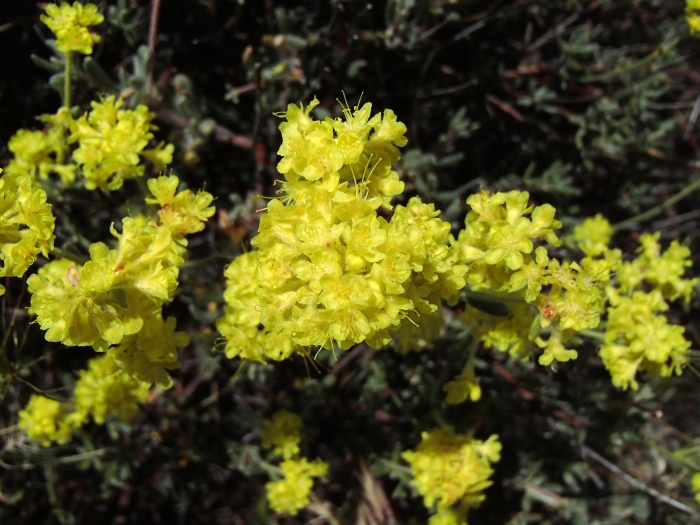Rock Buckwheat
(Eriogonum sphaerocephalum)
Rock Buckwheat (Eriogonum sphaerocephalum)
/
/

Tom Wainwright
CC BY 4.0
Image By:
Tom Wainwright
Recorded By:
Copyright:
CC BY 4.0
Copyright Notice:
Photo by: Tom Wainwright | License Type: CC BY 4.0 | License URL: http://creativecommons.org/licenses/by/4.0/ | Rights Holder: Tom Wainwright | Publisher: iNaturalist | Date Created: 2023-06-14T11:43:26-07:00 |

























Estimated Native Range
Summary
Eriogonum sphaerocephalum, commonly known as Rock Buckwheat or Round-headed Desert Buckwheat, is a perennial herb native to the Great Basin and surrounding areas of the western United States, including the sagebrush steppe, rocky outcrops, and desert flats. It is found at elevations between 2,000 and 7,000 feet in states such as Washington, Oregon, Idaho, northern California, and northern Nevada. Typically, this plant grows up to 20 inches in both height and width, with a woody base (caudex) and erect flowering stems. The foliage is covered in a dense woolly mat, and the plant produces clusters of yellow flowers that resemble small spheres, blooming from late spring to early fall.
Rock Buckwheat is valued for its drought tolerance and ability to thrive in poor, rocky soils, making it an excellent choice for xeriscaping and rock gardens. Its showy yellow flowers attract pollinators such as bees and butterflies, adding ecological value to the garden. In cultivation, it requires minimal maintenance, needing only full sun exposure and well-drained soils. It is not commonly affected by diseases or pests, but overwatering can lead to root rot. Rock Buckwheat is also used in restoration projects due to its adaptability to harsh conditions.CC BY-SA 4.0
Rock Buckwheat is valued for its drought tolerance and ability to thrive in poor, rocky soils, making it an excellent choice for xeriscaping and rock gardens. Its showy yellow flowers attract pollinators such as bees and butterflies, adding ecological value to the garden. In cultivation, it requires minimal maintenance, needing only full sun exposure and well-drained soils. It is not commonly affected by diseases or pests, but overwatering can lead to root rot. Rock Buckwheat is also used in restoration projects due to its adaptability to harsh conditions.CC BY-SA 4.0
Plant Description
- Plant Type: Shrub
- Height: 0.5-1.5 feet
- Width: 0.5-2 feet
- Growth Rate: Slow
- Flower Color: Pink, White, Yellow
- Flowering Season: Spring, Summer
- Leaf Retention: Deciduous, Semi-deciduous
Growth Requirements
- Sun: Full Sun, Part Shade
- Water: Low
- Drainage: Fast, Medium
Common Uses
Bee Garden, Butterfly Garden, Drought Tolerant, Low Maintenance, Rock Garden, Showy Flowers
Natural Habitat
Native to the Great Basin and surrounding areas, including sagebrush steppe, rocky outcrops, and desert flats
Other Names
Common Names: Roundhead Buckwheat, Carpet Buckwheat, Spurry Buckwheat, Brownflower buckwheat
Scientific Names: , Eriogonum sphaerocephalum, Eriogonum ellipticum var. megacephalum, Eriogonum geniculatum, Eriogonum sphaerocephalum, Eriogonum sphaerocephalum subsp. megacephalum, Eriogonum sphaerocephalum subsp. typicum, Eriogonum sphaerocephalum var. brevifolium, Eriogonum sphaerocephalum var. brevifolium, Eriogonum sphaerocephalum var. geniculatum
GBIF Accepted Name: